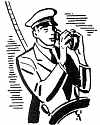 Now to determine the location of a ship at sea, you compare the
time on shipboard - obtained by observing a star or the sun - with the
time at Greenwich, England. The Greenwich time is kept by the ship's
chronometer.
Now to determine the location of a ship at sea, you compare the
time on shipboard - obtained by observing a star or the sun - with the
time at Greenwich, England. The Greenwich time is kept by the ship's
chronometer. In order to test this system, Harrison put his chronometer on a boat and made a test run from Jamaica, West Indies, to Portsmouth, England. The journey lasted more than two months, and during this time the chronometer varied only one minute and five seconds which was well within the limit required to win the $100,000.00 prize. After this trip, the inventor was known as "Longitude" Harrison. He had started the design of his chronometer at the age of thirty-five - yet he did not receive all of the $100,000.00 prize until he was seventy-six. The Board of Longitude was unwilling to admit that his repeated successes were little more than lucky accidents, and it took the personal influence of King George III to get the final pay-ment. While Harrison was having difficulties in collecting his money, his chronometer became a necessity for any long journey. These long trips were the direct result of the theory of Copernicus which had been opposed for several hundred years. Most men now knew the earth to be round and the fear of becoming lost over its edges was gone. Navigation was one of the great new industries. |








